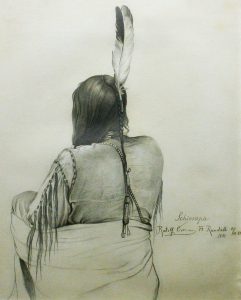View artwork
Rudolf Daniel Ludwig Cronau was born in Solingen, Prussia (Germany) in 1855. He was a Düsseldorf-schooled artist who made several trips to America as a newspaper correspondent. Additionally, he was a prolific writer of magazine articles and books relating to his western travels, American history, and German contributions to America. In 1900 Cronau became an American citizen and settled in New York to write and maintain a studio.
Initially, Rudolf Cronau was sent to America in 1881 by the German newspaper Die Gartenlaube to write a series of articles and create drawings of American life from the East coast to the West coast. After working on the East coast, he traveled down the Mississippi River, up the Missouri River through Kansas and Nebraska, to Wyoming and other western states, and then Louisiana and Florida. The next year, in 1882, Cronau made the trip to the West Coast by Union Pacific Railroad.
During his travel on the Missouri River, Cronau stayed for six months in 1881 at Fort Randall and on the Standing Rock Reservation among the Sioux Indians. This visit created a long-standing friendship between Sitting Bull and Cronau, and the artist painted the first life portrait of Sitting Bull. Fort Randall (1856-1892) was located south of the Missouri River below the present Fort Randall Dam in South Dakota near the Nebraska border. The Fort was built to protect settlers and explorers along the Missouri River in southern South Dakota and northern Nebraska as they traveled across the plains from the upper Missouri River and the Platte River to the south. The post also protected the Teton Sioux and Ponca reservations from illegal settlement by miners and homesteaders.
Most of Rudolf Cronau’s work is in pencil, some in pen, and there are a few watercolors. Some of his drawings were transferred into collotypes, a photo printing process using gelatin. When Cronau returned to Germany in 1882, he published 50 collotypes in a book about his American visit entitled Wunderland to Wunderland. Cronau’s drawings are noted for their detail and precise craftsmanship in the German romantic style of the Royal Academy in Düsseldorf.
Works by Cronau are in the permanent collections of the Amon Carter Museum of American Art (Fort Worth, Texas), Thomas Gilcrease Museum (Tulsa, Oklahoma), Brooklyn Museum (New York), and Tucson Museum of Art (Arizona.)
Rudolf Daniel Ludwig Cronau died in 1939 in Tarrytown, New York.
Researched and written by Jerald Fox, 2011, a project of MONA’s Bison Society.
Additional information provided by Sandra J. Mahalek, 2013.
Sources:
“Rudolf Daniel Ludwig Cronau.” Ask Art: The Artists’ Bluebook. Accessed Sep. 13, 2013. http://www.askart.com/
“Rudolf Daniel Ludwig Cronau.” Taos and Santa Fe Painters. Accessed Sep. 13, 2013. http://www.rudolfcronau.com/










